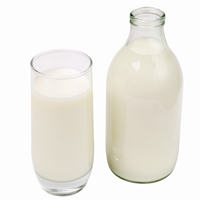All about Elsie
 While a good percentage of our food supply is global, the cow’s milk you drink hails from America, probably from a local dairy. Here’s what you’ll find in the carton.
While a good percentage of our food supply is global, the cow’s milk you drink hails from America, probably from a local dairy. Here’s what you’ll find in the carton.
Varied fat content
In its unadulterated state, milk has no more than 4 percent fat. Farmers used to simply skim off the high-fat cream layer than naturally rose to the top to make low-fat milk. Now dairies use centrifuges to spin off the fat, resulting in milk of varying fat levels.
Processing
About 95 percent of U.S. milk is pasteurized (quickly heated, then cooled to destroy bacteria and microorganisms). Most milk is also homogenized to prevent fat molecules from separating, keeping it smooth and creamy.
Hormones
Are the hormones in milk safe to drink? It depends on who you ask. All cows generate natural bGH, a hormone that helps them produce milk. Some dairies inject their milking cows with genetically engineered recombinant bovine growth hormone (rbGH, also known as rbST) to boost production. According to the Federal Drug Administration, milk from these cows is safe. But the European Union’s Scientific Committee on Veterinary Measures has said synthetic hormones may be linked with an increased risk of certain cancers. It also suggests more research is needed. Concerned? Buy organic milk or milk labeled “GMO-free”.
Organic
About 3 percent of America’s milk is organic. USDA rules require that organic cows be kept on pasture at least half the year, so they can obtain plenty of fresh grass. Organic cows may not be treated with synthetic hormones to boost milk production.
Can I cook with instant nonfat dry milk?
Absolutely! Add ¼ cup instant nonfat dry milk per 1 cup of fluid milk when making biscuits, muffins, pancakes, yeast breads and cakes to boost calcium and protein; add 2/3 cup nonfat dry milk per 1 pound ground meat when making meatloaf and meatballs (they’ll hold their shape better).

